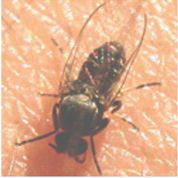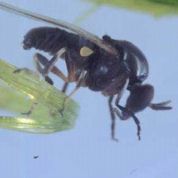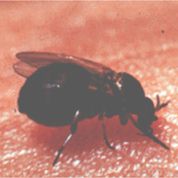


|
|
Black Fly
 |
 |
 |
| Common Name | Black Fly |
| Scientific Name | Simulium spp |
| Size | Black Fly is 1-5mm |
| Colour | Blackish, brown, grey and yellow |
| Description | Black flies are humped back, biting flies. It is possible that they may have a high population in the spring and early summer, especially in pasture areas along the streams. The immature stages are found in flowing water pupation occurs under the water and the adults float to the surface, ready to flight, feeding and mating. Black flies only feed during daylight hours. |
| Habitat | The outlets of ponds and lakes are particularly favoured and productive habitats. |
| Lifecycle |
|
| Disease Transmitted | River blindness |
| Symptoms | There maybe no symptoms manifested by an infected person. One of the three can be noticed from those who show the symptoms: skin rash, eye lesions, and/or subcutaneous bumps under the skin. |
| Type of Damage |
|
| Sources / Breeding | Males form hovering swarms and in some cases mating occur when
females fly into or near the swarms. In some cases mating occurs accidentally by becoming in contact with the ground or else where. |
| Prevention | The manipulation of water flows can be done so as to kill immature
black flies since they require running water. Black fly control is
difficult due to the highly migratory adult stage and their extensive
breed habitat. Personal protection is the most effective way of
preventing black fly bite. Black flies are so attracted to colours, so
it is better to wear light colours. Light coloured hats that cover the
ears are an important precaution. The repellent DEET (diethyl toluamide)
is effective in preventing black fly bites. Larval control can be practiced in areas were chronic black fly problems occur and breed areas are known. This involves metering of Bacillus thuringiensis namely. Israelensis into flowing water were larvae occurs. Adult black flies can be controlled with the use of permethrin-based products. |
| Control | Monitoring: Take the observational walk and search for the areas that are used by the black flies as breeding sites and decide what control measures are necessary. Physical: Biological: Chemicals: |
[ Home Page ]